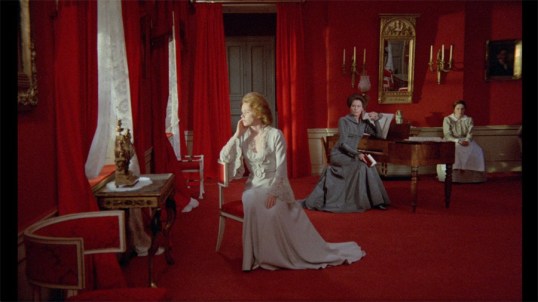The time is the 19th century. The country is Sweden. The setting is a mansion that is decorated with red carpet, red walls, and almost blindly white statues. But beyond that setting, the 1973 film Cries and Whispers is really set in the hearts and minds of four women. One of them is selfless. Two of them are bitter and uncaring. And one of them is slowly dying.
Agnes (Harriet Andersson) is the one who is dying. She spends her time laying in bed and screaming in pain. A doctor (Erland Josephson) provides her with no hope and can only promise that the end will come soon and a priest (Anders Ek) coldly goes about planning for her funeral and offering up empty promises of a final reward. Occasionally, through her diary and flashbacks to her youth, we get glimpses of who Agnes was before her life become dominating by her impending death.
Agnes’s sisters have come to the house to wait out her death. Though they’ve arrived to provide comfort, neither is capable of it. The youngest sister, Maria (Liv Ullman), was her mother’s favorite and has grown up to be coldly self-centered. Through flashbacks, we see the details of her affair with Agnes’s doctor. When Maria’s husband (Henning Moritzen) reacts to her infidelity by stabbing himself, Maria can only dispassionately watch. Meanwhile, the oldest sister, Karin (Ingrid Thulin) has grown up to be bitter and sexually repressed. In a truly shocking scene, Karin mutilates her vagina with a shard of glass and, after smearing the blood on her face, lies in bed and smirks at her husband.
In the end, only Anna (Kari Sylwan) can provide Agnes with any comfort. Anna is Agnes’s maid. Deeply religious and mourning the loss of her own daughter, only Anna is willing to reach out and hold Agnes while Agnes is in pain. And, after Agnes dies, Anna seems to be the only one who shows any real grief.
There are depressing movies and then there’s Cries and Whispers. Cries and Whispers is such an emotionally raw and dark movie that it was difficult for me to watch. It’s also difficult to review because just thinking about the movie brings up so many emotions. It’s just such a well-made and extremely painful movie.
It’s also an Ingmar Bergman film and that’s fortunate because Bergman somehow had an instinct for how to keep audiences watching even when the images on screen were amazingly painful. Visually, Cries and Whispers is as beautiful as it is thematically cold. By emphasizing the color red (not only is the entire house decorated in red but scenes often end by fading to red as opposed to black), Bergman makes the audience feel as if they truly have been transported into the human soul. Red, after all, is the color of blood and life.
And really, Cries and Whispers is one of those films that makes you wonder what exactly the point of life is. While the dream-like flashbacks give us clues as to how the three sisters became who they are, they also suggest that it really doesn’t matter. In the end, regardless of whether they’re in love or alone or happy or sad, they’re all going to die and that’s going to be it. All stories and issues will be left unresolved.
And, in the end, the best we can hope for is that someone like Anna will mourn us.
Cries and Whispers is one of the few foreign language films to be nominated for best picture. It’s also the only Ingmar Bergman film to be so nominated (though Bergman had more success in the Best Foreign Language Film category). It lost to The Sting, a far happier film.

Pingback: Lisa Reviews An Oscar Nominee: The Emigrants (dir by Jan Troell) | Through the Shattered Lens
Pingback: The Best Picture Race In Review: The 1970s | Through the Shattered Lens